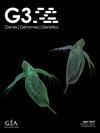濒危科罗拉多梭子鱼染色体级参考基因组的组装和注释
IF 2.1
3区 生物学
Q3 GENETICS & HEREDITY
引用次数: 0
摘要
基因组测序技术的进步为具有保护价值的物种提供了前所未有的高通量测序技术。为濒危物种提供高质量、有注释的参考基因组,可以最大限度地利用这些技术获得潜在的知识。然而,北美的濒危小鱼(鲤形目:Leuciscidae)往往缺乏这些重要资源。科罗拉多梭鱼(Ptychocheilus lucius)就是这样一个濒危物种,它是北美最大的鲦鱼,也是美国西南部和墨西哥西北部科罗拉多河流域的顶级本地水生掠食者。在过去的一个世纪中,科罗拉多梭子鱼因人为改变栖息地和引入入侵物种而导致栖息地丧失和种群数量减少。科罗拉多梭鱼基因资源的缺乏阻碍了对这种独特生物的基因组保护研究。本研究试图通过展示由太平洋生物科学公司 HiFi 测序和 Hi-C 支架开发的科罗拉多梭子鱼高质量参考基因组来弥补这一问题。最终组装的基因组为 1.1 Gb,由 305 个等位基因组成,其中包括 25 个染色体大小的支架。对质量、连续性和完整性的测量达到或超过了对 Danio rerio(丹顶鹤科)和科罗拉多河流域其他两种白鲦鱼(Meda fulgida 和 Tiaroga cobitis)的测量。比较基因组分析确定了生长、发育、免疫活动和基因转录基因家族的富集;所有这些对于生活在动态环境中的大型食鱼来说都很重要。该参考基因组将为科罗拉多梭鱼的重要保护基因组研究奠定基础,并有助于更好地了解沙漠鱼类的进化过程。本文章由计算机程序翻译,如有差异,请以英文原文为准。
Assembly and annotation of a chromosome-level reference genome for the endangered Colorado pikeminnow Ptychocheilus lucius
Advancements in genome sequencing technology have brought unprecedented accessibility of high-throughput sequencing to species of conservation interest. The potential knowledge gained from application of these techniques is maximized by availability of high-quality, annotated reference genomes for endangered species. However, these vital resources are often lacking for endangered minnows of North America (Cypriniformes: Leuciscidae). One such endangered species, Colorado pikeminnow (Ptychocheilus lucius) is the largest North American minnow and the top-level native aquatic predator in the Colorado River Basin of the southwestern United States and northwestern Mexico. Over the past century Colorado pikeminnow has suffered habitat loss and population declines due to anthropogenic habitat modifications and invasive species introductions. The lack of genetic resources for Colorado pikeminnow has hindered conservation genomic study of this unique organism. This study seeks to remedy this issue by presenting a high-quality reference genome for Colorado pikeminnow developed from Pacific Biosciences HiFi sequencing and Hi-C scaffolding. The final assembly was a 1.1 Gb genome comprised of 305 contigs including 25 chromosome-sized scaffolds. Measures of quality, contiguity, and completeness met or exceeded those observed for Danio rerio (Danionidae) and two other Colorado River Basin leuciscids (Meda fulgida and Tiaroga cobitis). Comparative genomic analyses identified enrichment of gene families for growth, development, immune activity, and gene transcription; all of which are important for a large-bodied piscivorous fish living in a dynamic environment. This reference genome will provide a basis for important conservation genomic study of Colorado pikeminnow and help efforts to better understand the evolution of desert fishes.
求助全文
通过发布文献求助,成功后即可免费获取论文全文。
去求助
来源期刊

G3: Genes|Genomes|Genetics
GENETICS & HEREDITY-
CiteScore
5.10
自引率
3.80%
发文量
305
审稿时长
3-8 weeks
期刊介绍:
G3: Genes, Genomes, Genetics provides a forum for the publication of high‐quality foundational research, particularly research that generates useful genetic and genomic information such as genome maps, single gene studies, genome‐wide association and QTL studies, as well as genome reports, mutant screens, and advances in methods and technology. The Editorial Board of G3 believes that rapid dissemination of these data is the necessary foundation for analysis that leads to mechanistic insights.
G3, published by the Genetics Society of America, meets the critical and growing need of the genetics community for rapid review and publication of important results in all areas of genetics. G3 offers the opportunity to publish the puzzling finding or to present unpublished results that may not have been submitted for review and publication due to a perceived lack of a potential high-impact finding. G3 has earned the DOAJ Seal, which is a mark of certification for open access journals, awarded by DOAJ to journals that achieve a high level of openness, adhere to Best Practice and high publishing standards.
 求助内容:
求助内容: 应助结果提醒方式:
应助结果提醒方式:


